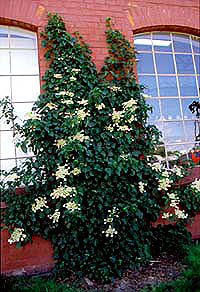Hydrangea - hortensia
 Climbing Hydrangea is native to Far East and is one of the most original and valuable climbing plants. It is closely related to Schizophragma hydrangeoides – Japanese Hydrangea, and they both belong to the Hydrangeaceae family.
Climbing Hydrangea is native to Far East and is one of the most original and valuable climbing plants. It is closely related to Schizophragma hydrangeoides – Japanese Hydrangea, and they both belong to the Hydrangeaceae family.
White flowers, produced in flat corymbs at the turn of June and July are its main attraction. It also has interesting ovate green leaves on long petioles. The leaves turn yellow in autumn.
It climbs by means of adventitious rootlets. Its slightly twining stems look very attractive in winter, covered with red-brown or vermillion-brown, peeling bark. The plant is slow to get going and it produces little new growth in the first two, three years, but once it's well established, it will start growing vigorously, producing even up to 1 m of new growth a year and attains the final height of 10-20 m.
- 'Mirranda' – a new valuable cultivar with yellow-margined leaves. Very useful for creating colourful combinations.
 Hydrangea anomala subsp. petiolaris Hydrangea anomala subsp. petiolaris |
Requirements
Hydrangea thrives in a sheltered position, in half-shade or even complete shade, and in humus-rich, moist but not waterlogged soil. It doesn’t cope well with drought. It prefers acid soil, but tolerates slightly alkaline soil. Its full hardiness makes it highly popular in many countries, especially with a harsher climate (Norway, Sweden, Finland, Germany). It’s often used as a hardy alternative to ivy that tends to freeze during severe winters. Well tolerant of pruning though it doesn’t have any special pruning requirements.
Application
It's suitable for covering arbours, pergolas, trellises and arches. Ideal for growing up trees, pylons, columns and walls with a porous surface. You should remember, however, that adventitious rootlets are too weak to attach a mature plant securely to a smooth surface, especially with a strong wind. Therefore, if you plan to grow your Hydrangea next to the wall, it’s better to provide the plant with additional support, like metal rods or strips of wood. It may also grow without any support at all, as a picturesque groundcover plant in shaded areas.













